The theatre on the banks of the Ingulets
General Introduction
Incredibly, the effort to sustain the notion of an ongoing Ukrainian counteroffensive in Kherson continues one week after it was spoken into existence, and a considerable number of days after it was first confidently reported as being comprehensively quashed. Today, liveuamap.com, with its bias for Kiev, even changed its maps to show gains in two lengths of the line in favour of Ukraine. Notably it did this without any accompanying announcement (unlike it is wont to do), and not one by the General Staff of the Armed Forces of Ukraine, which appears to be the usual and primary source of the information collated by liveuamap.com. Indeed, the detachment from officialdom wouldn’t surprise: it has become common knowledge that the Ukrainian authorities were not to make comment about their activities relating to Kherson at this time. Moreover, it also became widely understood that Ukrainian open source intelligence (OSINT) aggregators and embedded journalists were likewise not to report.
So, it is pretty clear that any impression of a sustained campaign waged by the Ukrainians has been created by supposedly pro-Russian OSINT-mongers, and in particular one collective of intelligence gatherers that goes by the name of Rybar. Indeed, the author suspects that liveuamap.com has taken advantage of the information that Rybar has been producing in affecting the change that it has made to its maps, for the reporting by Rybar has promoted the notion of a great deal of Ukrainian dynamism. For his part, the author has found the accounts to be implausible, and can point directly to one deliberate effort to mislead, and so has come to the conclusion that Rybar has been working in the interests of presenting an impression of Ukrainian threat. Moreover, that this activity appears to have facilitated Ukrainian propaganda, the author has no reason to understand Rybar to be a credible, independent source.
Naturally, some Rybar coverage is going to be examined in the course of this piece because the intrusion by this organisation gonzo-style into the story forms part of the narrative, but the objective is not to dedicate an entire work to a complaint about seriously dodgy operatives. Besides which, some warning was needed before the presentation here of the liveuamap.com regarding what it reckons is the current situation in a stretch of frontline along the banks of the Ingulets – which is the area of front of our focus in this article. There will be an opportunity in the body of this piece to compare the map (shown in Fig. 1) with a previous version by the same makers to see the extent of newly claimed Ukrainian gains, but for the time being the reader is asked to compare with a map extracted from a Russian Ministry of Defence (RMoD) presentation of 4th September which appears to show no such Ukrainian holdings on the south of the Ingulets. Indeed, the Russians appear to control all territory on their side of the river. In conjunction with this presentation (on the same date), the RMoD would only say this of Ukrainian activity: “[the] Kiev regime continues its unsuccessful attempts to consolidate at several areas towards Nikolayev-Krivoy Rog direction.” This is referring to unspecified activity in a larger area, not just in this particular Ingulets stretch, but what is helpful is how the RMoD thinks that wherever the Ukrainian forces are, their efforts are concentrated on not being dislodged.
The Situation as of 28th August
It was on 27th July when the Ukrainians claimed that they had liberated Lozove and Andriivka (as shown in Fig. 3) and created the situation at this part of the front line as it was on 28th August. Basically, the Ukrainians became the owners of a “bridgehead” on the Russian side of the Ingulets River – and this statement has been carefully worded for a good reason. As shown in Fig. 4, it was a parcel of land 7 miles at its longest, and 3.5 at its widest, and it didn’t have a bridge anywhere in it. So, it was an odd piece of territory for the Ukrainians to possess. If the Ukrainians had an idea that they could thrust out an attacking prong in counter manoeuvres from this place, then it was a crazy idea, because a reliance on pontoons would form a bottleneck, and there’s not much territory on the Russian side to form a staging area. The Russians could just blow vehicles up as they cross the river to cause a blockage, and whatever was already on the other side would be trapped.
Then there is the matter of how the Russians denied the Ukrainians any place along the river where there was a permanent crossing. Davydiv Brid, where there is such a thing, the Ukrainians failed to capture at the same sort of time it obtained the bridgehead. The next one in the western direction is at a place not shown on Fig.4, but is shown on Fig. 3: Kalynivske – under Russian control since April. One is tempted to say that the Russians tolerated the Ukrainians in the bridgeless space between the two settlements – perhaps because of its seeming redundancy. Besides which, it is clear from RMoD briefings from 12th to 23rd August that, when they felt it necessary, the Russians acted to prevent the Ukrainians from organising themselves in this space and on the northern river bank. The following is a casually researched list of carnage by Russian aerospace forces that is very unlikely to be exhaustive:
A platoon of Grad multiple-launch rocket systems suppressed at Velikaya Aleksandrovka; 100 fighters and 9 pieces of military equipment of AFU’s 28th Mechanized Brigade destroyed near Novogrigoryevka; 160 nationalists from the 105th and 107th battalions of the Ukrainian 63rd Mechanized Brigade killed near Belogorka and Lozovoye; 20 nationalists killed and 30 wounded at the deployment point of the 46th Airmobile Brigade near Lozovoye; 40 nationalists and 10 units of special vehicles destroyed at Lozovoye, Belogorka and Belaya Krynitsa; 80 nationalists killed, with more than 50 injured from the 18th Battalion of 35th Marines’ Brigade near Belaya Krynitsa and Velikoye Artakovo; a command post of the 46th Airmobile Brigade destroyed near Belaya Krinitsya.
Then, fascinatingly, on the 24th August, the RMoD reported this:
18th Battalion of 35th Marine Brigade of AFU has been defeated near Lozovoye, Kherson Region, while attempting to stealthily cross the Ingulets River. More than 80 nationalists and 6 vehicles have been destroyed.
This was followed by another very interesting piece of information released on 27th August:
Units of 46th Airmobile Brigade of AFU have been defeated near Lozovoye, Kherson Region, after another attempt to stealthily cross the Ingulets River. The enemy suffered losses of over 130 fighters and 10 pieces of military equipment.
What all of this indicates is disrupted attempts to cross the Ingulets clandestinely. It indicates that the Ukrainians knew that they couldn’t cross the river out in the open, and to some extent had to muster in the small tract of land on the Russian side of the water.
So, it is very hard to imagine why and how the Ukrainians still thought that they could mount an attack from this place when they were routinely being disorganised by Russian air power, and even being hit as they were crossing the Ingulets. The author’s feeling is that after the bridgeless bridgehead fell into their lap on 27th July, the Ukrainians could not even consider abandoning it for reasons of propaganda, and perhaps rationalised that they could “fall forward” into a much less poor position at some point in the future if they but remain in place. Indeed, the author’s feeling is that the so-called Ukrainian counteroffensive of 29th August can be reduced to an effort to make something of a bad lot at this point at the line, with other fighting (or rumours of it) being window dressing. In other words, wider activity along the Kherson front was disguise for what was essentially an effort to avoid a central propaganda fail. Obviously, the effort to rectify their poor position started much earlier than the 29th August, and was immediately countered by the Russians – as the RMoD accounts testify.
The Ukrainians at Sukhyl Stavok
On 31st August, evidence by then existed to indicate that the Ukrainians, at least, had at some point advanced into Russian-controlled territory towards or even beyond the one-street hamlet of Sukhyl Stavok because the situation was referenced in an RMoD Telegram posting of that day: “Battalion of 57th AFU Motorised Infantry Brigade has been defeated near Sukhoi Stavok. The elimination of its remnants is currently being completed.”
What is clearly suggested is that Ukrainian momentum had been stopped, intent foiled, and the Russians were in the process of punishing the failure. No other information came to light in the initial three day period to contradict this impression, so that it could be said for certain that the Ukrainians had achieved anything other than travelling part or all of the 0.9 miles from their lines to Sukhoi Stavok before they were forced to abandon their manoeuvres.
The author has noticed the existence of one piece of footage that has emerged since the 31st (that quite easily could have been filmed before that date) that claims to show the Ukrainians beyond Sukhoi Stavok towards a settlement called Kostromka. However, this wouldn’t necessarily conflict with a Russian account of an engagement near the former settlement. Indeed, where the Ukrainians are in this area in particular is not the issue. The issue is whether or not they are participating in a coordinated, extensive operation aimed at liberating the entire Kherson region (as the mythology has it), or whether they are acting in isolation in a flailing effort to fight (or fall) forward to solve a local problem. The author is inclined to think that it is the second case.
There was nothing to change this view after seeing the information presented in a RMoD video briefing of 3rd September. The map in Fig. 2, of course, was extracted from such like material. Granted, the maps that the RMoD show in their video briefings have a certain look (and are skewed, though one doesn’t notice this until one scrutinises them) to make them abstract: no one should expect them to be perfectly detailed. However, they are also eminently useful for appreciating how the Russians want their situation to be perceived – why else would they shade areas of Ukraine with red other than to create an impression of their military disposition.
In Fig. 5 the orange line is one that approximates the edge of the red shading in the map of Fig. 2 as it relates to the particular area of our interest. The blue shaded area is the Ukrainian bridgehead on the Russian side of the Ingulets as of 28th September. The yellow line is the line of contact as of 28th September according to liveuamap.com. What stands out when the data is overlaid into one picture is the suggestion of Russian extension after the Ukrainian project, not just through the bridgehead, but also to the north and west of it.
Now, it has to be said that the graphic is not hard evidence, and that there is such scope for error in the process of detecting where the orange line should be routed so that the result should not be considered to be more than a rough estimate. That being said, another graphic produced in the same way to deduce the extent of Russian control beyond that which is granted by the Ukrainian side has been validated by events. This will be explained in greater detail in subsequent articles in this series, but the document in question can be seen (proving itself) in the parent to this article, The Ukrainian Kherson Counteroffensive That Was Over Before It Began, Or Never Was – Again. In the end, ultimately, the information used to create the graphic is official, so what can be seen above is a document that represents an individual applying first hand source material in an exercise of seeing is believing, and there should not be cause for surprise if it does turn out to portray reality.
Talking of which, there is seriously little hope of obtaining an unobscured view of such a thing as reality when information is weaponised (and it is never more so than when it pertains to a war) and is purveyed by a legion of OSINT-mongers – some of them under orders to deceive, some of them being sensational for monetised clicks, some of them being wrong out of plain stupidity – ultimately so that it is able to convince an audience (who can’t prove either case) that what is taking place over here is in fact happening over there – or, indeed, what is not happening at all is taking place as furiously as possible it might be.
This brings us neatly to the concluding section of this article.
Nonsense Stories
Consider the following extracts taken from RMoD briefings on the dates shown:
30th August:
As a result of the defeat of the Ukrainian offensive on Zelensky’s personal orders in Nikolaev-Krivoi Rog and other directions, the enemy suffered significant losses.
Effective actions of the Russian groupping of troops have destroyed 48 tanks, 46 infantry fighting vehicles, 37 other armoured fighting vehicles, 8 pick-up trucks with large-calibre machine guns and over 1,200 Ukrainian servicemen.
1st September:
The Kiev regime continued unsuccessful offensive attempts on Nikolaev-Krivoy Rog direction.
Russian Aerospace Forces aviation, missile troops and artillery inflicted significant damage on advancing Ukrainian units and reserves.
In the past 24 hours alone, the enemy has lost 31 tanks, 22 infantry fighting vehicles, 18 other armoured combat vehicles, 8 pick-ups with heavy machine guns, 17 pieces of special vehicle equipment and over 350 servicemen in the course of combat operations in this area.
2nd September:
Kiev regime continues its unsuccessful attempts to gain a foothold in certain areas in Nikolaev-Krivoy Rog direction.
Russian Aerospace Forces aircraft, missile troops and artillery inflict significant losses on Ukrainian units and reserves.
In just one day of combat operations, the enemy has lost 13 tanks, 19 infantry fighting vehicles, 12 other armoured vehicles, 11 pick-ups with large-calibre machine guns and over 330 servicemen. Two militants are taken prisoner.
2 Ukrainian Su-25 assault aircraft and 1 MiG-29 fighter, which had been re-equipped to use US HARM anti-radiation missiles, have been shot down near Andreevka, Kherson Region.
High-precision weapons of the Russian Aerospace Forces have hit a temporary deployment point of 17th Tank Brigade near Bereznevatoye and hangars with weapons and military equipment of 46th Airmobile Brigade near Belaya Krinitsa, Nikolaev Region. The attacks have resulted in the destruction of up to 40 nationalists and 10 units of military equipment.
(Bereznevatoye is a town to the north of the immediate area of our interest).
3rd September:
Kiev regime continued its unsuccessful attempts to consolidate at several areas towards Nikolayev-Krivoy Rog direction.
The enemy has lost 23 tanks, 27 infantry combat vehicles, 14 armoured combat vehicles of other types, 9 pick-ups with large-calibre machine guns and over 230 servicemen.
Moreover, fighter aviation of Russian Aerospace Forces has shot down 2 Ukrainian Su-25 assault fighters near Sergeyevka (Kherson region), as well as 1 MiG-29 of Ukrainian Air Force converted for launching HARM anti-radar missiles near Novosyolovka (Dnepropetrovsk region).
High losses of the Armed Forces of Ukraine (AFU) at Nikolayev-Krivoy Rog direction have led to a severe lack of beds, medication and blood supplies in healthcare establishments of Nikolayev and Nikolayev region.
To detect and detaining the increased number of deserters, more military patrols were redeployed to Nikolayev and additional posts were deployed at the approaches to the city.
4th September:
Kiev regime continues its unsuccessful attempts to consolidate at several areas towards Nikolayev-Krivoy Rog direction. Aviation of Russian Aerospace Forces, missile troops and artillery launch attacks at the units and reserve forces of the Armed Forces of Ukraine (AFU).
The enemy has lost 11 tanks, 17 infantry combat vehicles, including 4 U.S.-manufactured Bradley vehicles, 10 other combat armoured vehicles, 5 pick-ups with large-calibre machine guns and over 150 servicemen at the abovementioned direction.
Fighter aviation of Russian Aerospace Forces have shot down Su-25 assault fighter of Ukrainian Air Force near Romanovka (Nikolayev region).
First of all, the RMoD is talking about events happening beyond and including the area of our interest, so the numbers do not reflect an outcome solely at the Ingulets, although one should think that it is such a poor choice from which to throw out an assault that it contributes more than its fair share.
What we should note especially is the decreasing numbers of Ukrainian fighters presumably killed, which starts off astronomically high after the commencement of this engagement, then comes in at about a quarter of the initial peak for two days, then continues to drop over the course of another two. What is clear is that the Ukrainians got a huge shock in the first instance – but what happened next? Did the Ukrainians continue aggressively pursue an offensive, as an account we are about to look at claims, or did something else happen? Well, the author would suggest that these numbers are not indicative of the Ukrainians throwing a sustained mass at an operation, because the Russians begin to destroy more armoured vehicles in proportion to fighters. Abandoned or parked tanks and IFVs and wot-not will count as destroyed examples of the vehicle surely as much as inhabited ones – the only difference is that when the abandoned type are destroyed, there’s no coinciding human casualty. The next RMoD briefing is due soon, so it will be interesting to see what further indicators it gives†. However, it is feasible to argue that what has been happening from 1st September onwards is the result of the Russian diligence in hunting down targets to demilitarise that we’ve come to expect, with all the difference being made by the Ukrainians having exposed themselves out in the open. As is clearly inherent in the hypothesis, this doesn’t signify that the Ukrainians are making a continued integrated attack into Kherson, or indeed making any isolated local attacks.
On the other hand, there has very much been an idea in the zeitgeist that the Ukrainians remain dynamic long after their initial pummelling when they were surely metaphorically, if not literally knocked backwards, and this appears to be due largely, if not entirely, to the OSINT-mongery of one organisation in particular (aided by countless useful idiot or paid-for social media regurgitators).
On 31st August, Rybar was portraying the action at the Ingulets as an offensive targeting Davydiv Brid which got stopped at that town and also as it swung from the south. This scenario would be the safest bet for anyone who wanted to commentate on the situation but had no idea what was really happening, because it makes best sense for the Ukrainians to target the permanent bridge at Davydiv Brid. What doesn’t make sense in this map in Fig, 6, having seen the liveuamap.com, is why the Ukrainians are constraining themselves to an extended bottleneck. The explanation, according to Rybar, is that this is forced by actual Russian areas of control which don’t correspond with Ukrainian reckoning. Of course, we might expect variations, but what makes the Rybar map unconvincing is the Russian presence in a hook on the southern side of the Bila Krynytsya stretch. The author doesn’t understand why the Russians would expose themselves in such a manner, and notes that the contrivance has such a detrimental affect on Ukrainian prospects by narrowing their access to the river that it contradicts what is represented by the blue arrows burrowing into the Ukrainian tunnel. It’s clear that what is going on in this map is an excuse for why the Ukrainians could not capture Davydiv Brid (i.e. Russian padding).
On the 2nd September, Rybar resurrected the Ukrainian campaign at the Ingulets (see Fig.7) – but obviously couldn’t decide what new objective was being pursued, and had the Ukrainians wandering to the south to be destroyed there (just as if they never actually arrived).
On 3rd September, according to Rybar, the Ukrainians had captured Ternivka and Blahodativka on the western wing of the Russian encirclement (see Fig. 4 for details) and was routing newly arrived Leopard tanks through these places to Andriivka and the front. At first these tanks were from Italy until someone realised that the Italians never had any, and then the social media regurgitators were thereafter content to report some other country as source. With all his experience at looking at this sort of thing, the author thinks that facts like these cannot be mistaken if the accounts are based on reality. Incidentally, and it is not known if Rybar initiated this or not, with their own pontoons now destroyed, the Ukrainians were able to capture Blahodativka by using a temporary bridge (or bridges) assembled by the Russians. Now, of course, apart from the bit about the denial of the Ukrainian’s own crossings, this appears to be nonsense – because in a world where children are not begging to be entertained, there is no good reason for the Russians to need to cross the river at this location – certainly not while any of this was going on – and there is no evidence of the Russians previously being interested in doing such a thing. Why would the Russians have built pontoons here? Even if they were hastily erected by the Ukrainians, how was that possible in the heat of this battle?
Obviously, the purpose of the story is to explain how the Ukrainians could continue when routes from their original bridgehead were blocked to them (as is being shown in Figs. 8 and 9).
On 4th September, (looking at Fig. 9) the Russians had cleared or encircled the southernmost of the Ukrainian venture, and was attacking the original Ukrainian bridgehead and the territory to the west of it that had been lost. Evidently, the Ukrainians were still willing to run the gauntlet of their Ternivka-Blahodativka-Andriivka, but at the same time, Rybar had wholly forgotten about what objective would drive them to do this. Indeed, according to the map in Fig. 9, one cannot see a good reason why the Ukrainians would persist. The mission to the south is defeated, and the Ukrainians have stumbled (according to Rybar) into possession of more second rate territory. Or to put it a slightly different way, the Ukrainians are still hemmed in on the wrong side of the river, albeit more expansively. And meanwhile, like God, the Russians can surely giveth and taketh away – and we’re talking about the supposed pontoon bridges that the Ukrainians had to come to rely on to remain connected to their bridgehead.
Although there are no more samples of Rybar fairy tale to examine in this exercise, one can see that they are on a “Russia wins in the end” trajectory, and this is to be expected, because they want to keep their pro-Russian audience. Sly is the word for it, because in this exercise Rybar has clearly created the groundwork for a divergence that the Ukrainians can present as the truth – and indeed are – where the Ukrainians are successful in the end. And there’s no more clear cut demonstration of this facilitation by Rybar than the feature in the liveuamap.com of Fig. 1 which makes hay with the Ternivka-Blahodativka-Andriivka tank story. And in fact when the propaganda is so helpful as it is in this case, it smacks of direct collaboration. In fact, that’s what the author would call it.
† Update, 15.35, date as published:
The briefing for 5th September:
The Armed Forces of Ukraine (AFU) continued their attempts to consolidate at several areas of Nikolayev-Krivoy Rog direction.
Russian Aerospace Forces, missile troops and artillery launch high-precision attacks at the units and reserve forces of Ukrainian troops.
The enemy has lost a total of 11 tanks, 7 infantry combat vehicles and 8 armoured vehicles of other types, 9 pick-ups with large-calibre machine guns and over 220 servicemen at the abovementioned direction.
Moreover, high-precision armament has neutralised provisional bases of 57th Mechanised Infantry Brigade near Bereznegovatoye and Murakhovka (Nikolayev region).
Russian Aerospace Forces have shot down 1 Mi-8 helicopter of Ukrainian Air Force near Kochubeyevka (Kherson region).
2 depots for missiles, artillery armament and munitions of the AFU have been destroyed near Voznesensk and Ochakov (Nikolayev region) that storaged over 1,500 rocket-propelled projectiles for multiple rocket-launching systems (MRLS), including over 200 projectiles for U.S.-manufactured HIMARS multiple rocket launchers.
The briefing for 6th September:
The Armed Forces of Ukraine (AFU) continued their attempts to attack several areas of Nikolayev-Krivoy Rog direction.
Russian Aerospace Forces, missile troops and artillery launch high-precision attacks at AFU units and reserve forces.
Manpower and military equipment at the provisional bases of 61st Infantry Brigade, 35th Marines Brigade and 17th Tank Brigade of the AFU have been neutralised near Visunsk, Yavkino, Bereznegovatoye and Chervonopolye.
3 depots of missiles, artillery armament and munitions have been destroyed near Velikoye Artakovo (Nikolayev region).
Launch of Kalibr high-precision long-range sea-based missiles has resulted in the elimination of a large fuel depot intended for Ukrainian troops at Nikolayevo-Krivoy Rog direction near Karpovka (Dnepropetrovsk region).
Fighter aviation of Russian Aerospace Forces and air defence means have shot down 3 Su-25 airplanes of Ukrainian Air Force. 1 Su-25 has been shot down near Snigiryovka and 2 Su-25 have been shot down near Mirnoye (Nikolayev region).
The enemy has lost a total of 12 tanks, 11 infantry combat vehicles and 8 other armoured vehicles, 6 pick-ups with large-calibre machine guns and over 210 servicemen at Nikolayev-Krivoy Rog direction.
The thing to note in these very latest reports is that casualties coincide with attacks on bases, and it suggests that the Russians are looking further than the battlefield for targets – suggesting that it is inhabited much less these days by active Ukrainians.




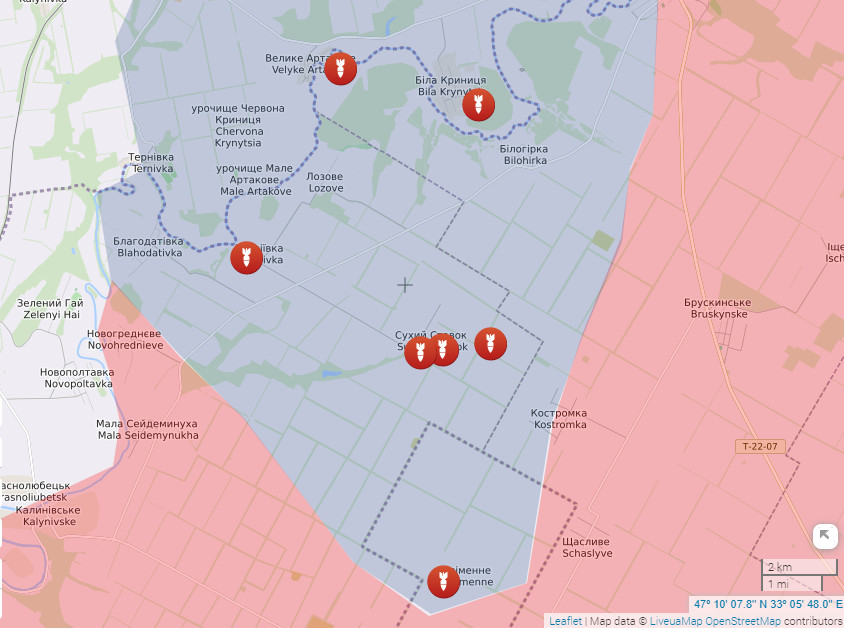
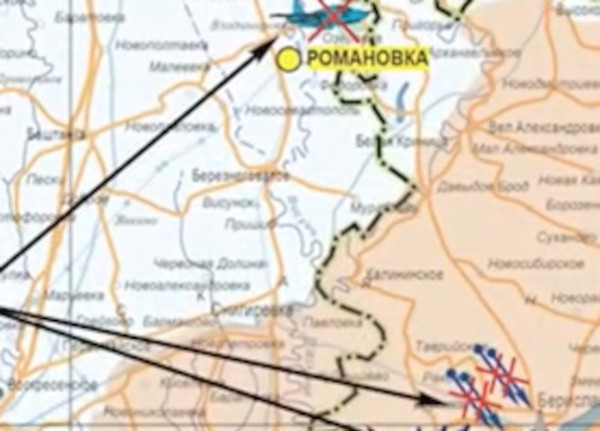
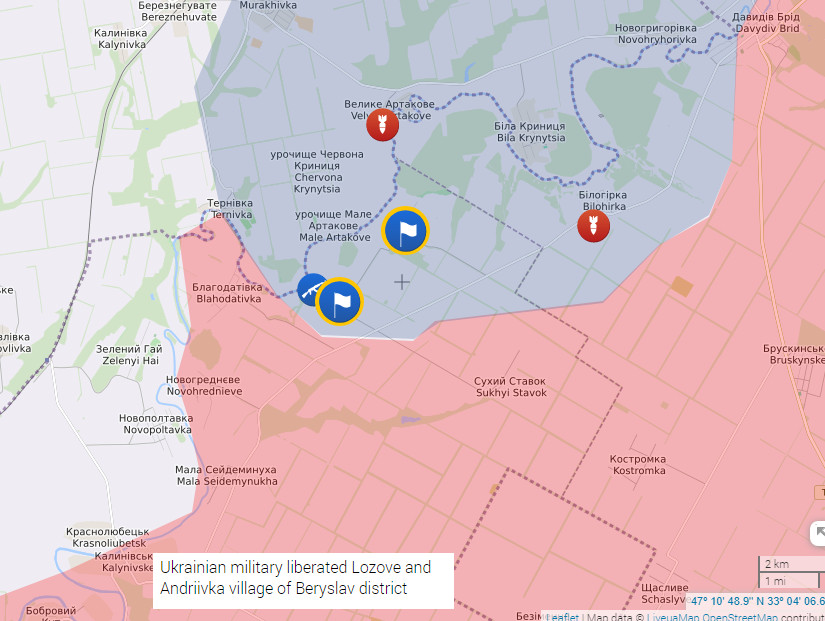
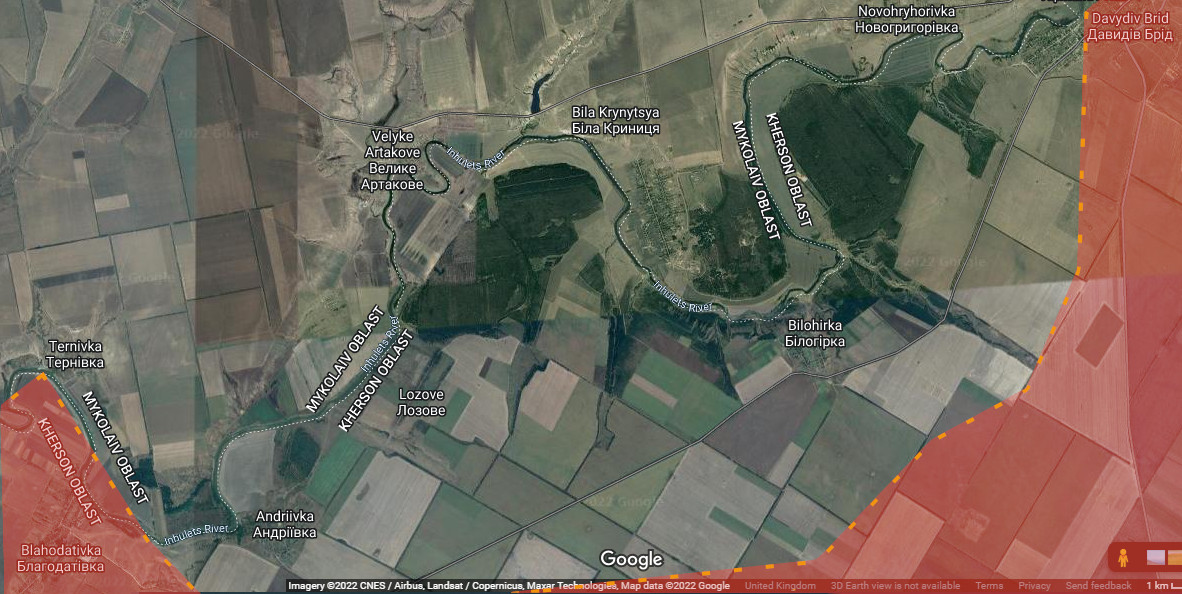
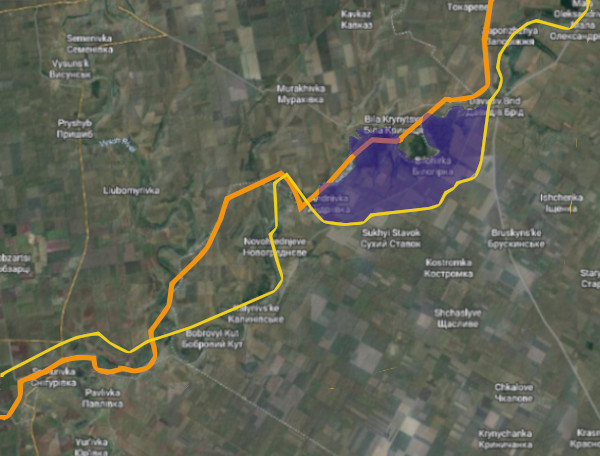
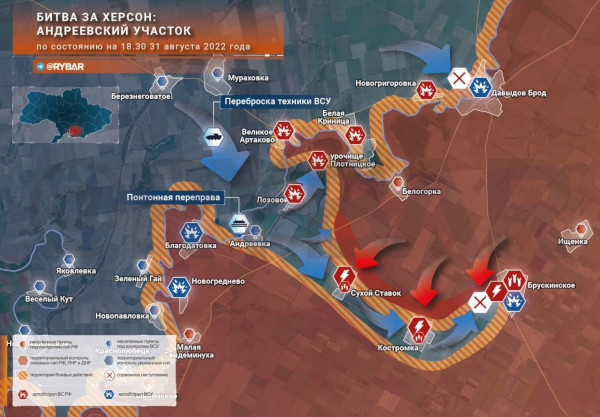
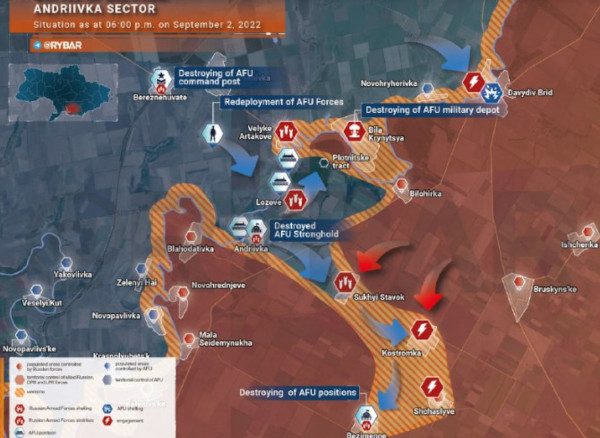
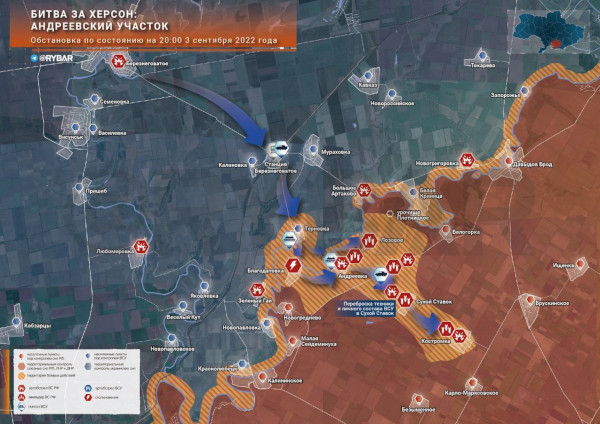
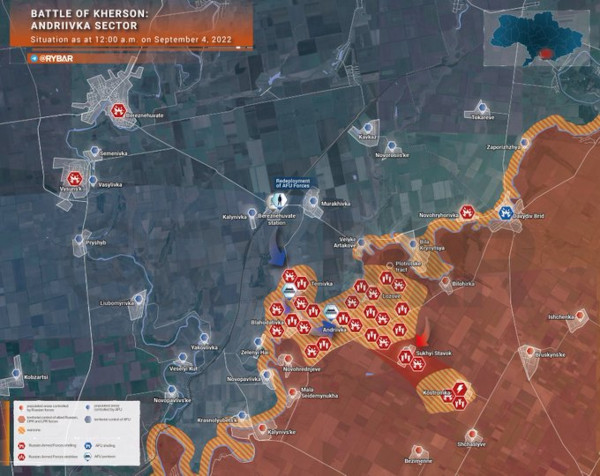


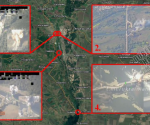
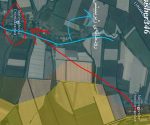











Russian propagandist website. 25,000 Buryatians with a river at their back and no way forward because they don’t have enough supplies to break out. The russians are well aware that there are stinger operatives in Kherson city but cannot find them so no close air support. The bridges are done for and the attempts by russians to use pontoons to ship supplies into Kherson West of the Dnipro are feeble and subject to daily HIMARS attacks. Ukraine only have to squeeze until the pips pop.
How are you going to spin it when the world is shown 25,000 dead russians or somewhat less than 25,000 Russian prisoners?